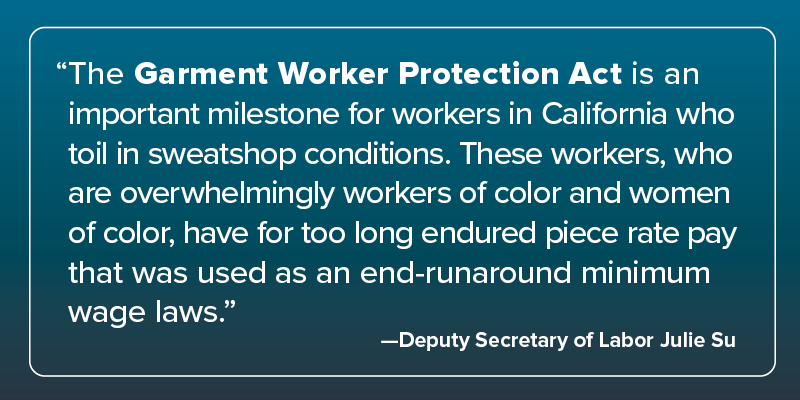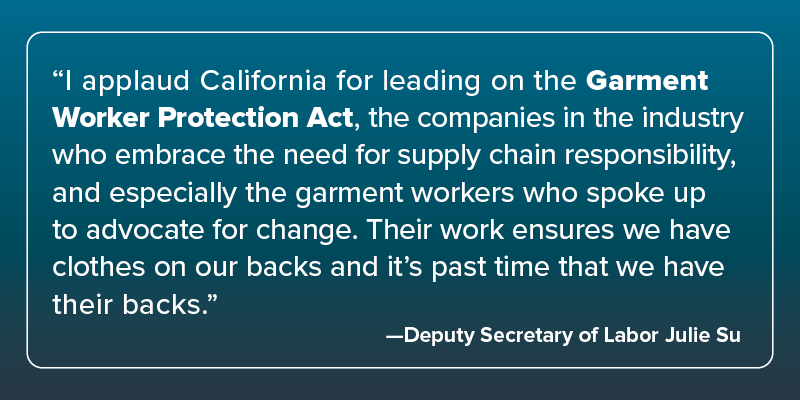
Some of the most vulnerable workers in the nation are those in the garment industry. Most garment workers are women and are sometimes paid wages under the federal minimum hourly rate of $7.25 per hour. The Department of Labor's Wage and Hour Division has made it a priority to protect these workers and ensure they earn the wages they are rightfully owed and guaranteed by law.
For example, the Wage and Hour Division helped Bertha Gonzalez recover $7,598 in unpaid wages as part of an investigation into her former employer, WUMC Clothing. Bertha told investigators that while she worked 8 hours a day when she first started in the garment industry in 1977, garment contractors now expect 10-12 hours per day, paying flat (hourly or piece) rates that have fallen over the years.

Asian and Hispanic garment workers like Bertha, as well as small garment shop owners, are often exploited by systemic and industrywide practices that result in wage and hour violations. Garment sewing shop owners, most of whom are recent immigrants themselves, are sometimes labeled as sweatshop operators. Because workers earn just a few cents per piece, it is impossible for most garment workers to earn the legally required minimum wage and overtime pay. However, the large multinational manufacturers and retailers who set low prices without regard to wage and hour laws are responsible for creating the economic pressures that result in what are often deplorable, inhumane working conditions.
Faced with the choice of affording basic necessities or failing to pay the bills, both garment contractors and workers have little choice but to participate in this exploitative system.
Wage and Hour Division investigations have shown repeatedly (2019, 2018, 2017, 2016, 2014) how the garment industry’s piece-rate system creates a cycle of labor exploitation. In 2016, we found that close to 86% of garment contractors investigated were found in violation of federal minimum wage and overtime standards.
On Sept. 27, California Gov. Gavin Newsom signed into law the Garment Worker Protection Act, a law that protects workers from abusive labor practices. California’s new law prohibits the common industrywide practice of paying by the piece – that is, a flat rate per garment completed. With this practice, workers like Bertha Gonzalez – a seamstress in Los Angeles’ fashion district who relied on Social Security checks to supplement her roughly $300/week income – are falsely led to believe that they can earn more if they work faster.

As a Wage and Hour investigator, changes in law impacting garment workers hold deep meaning for me and my colleagues. Department of Labor Deputy Secretary Julie Su, who has fought for the rights of garment workers since the beginning of her career, has applauded the State of California for their bold support of garment workers. The Wage and Hour Division will continue our critical work to enforce the federal Fair Labor Standards Act, and educate workers and employers about their rights and responsibilities, until everyone involved in this industry respects basic labor standards and the dignity of work – from the very first stitch.
Paul Chang is the Western Regional Anti-Human Trafficking Coordinator at the US Department of Labor’s Wage and Hour Division. As such, Chang helps prevent, protect, and refer cases involving exploitation of vulnerable workers. He has extensive experience investigating low-wage industries, including the El Monte slavery case.

 U.S. Department of Labor Blog
U.S. Department of Labor Blog